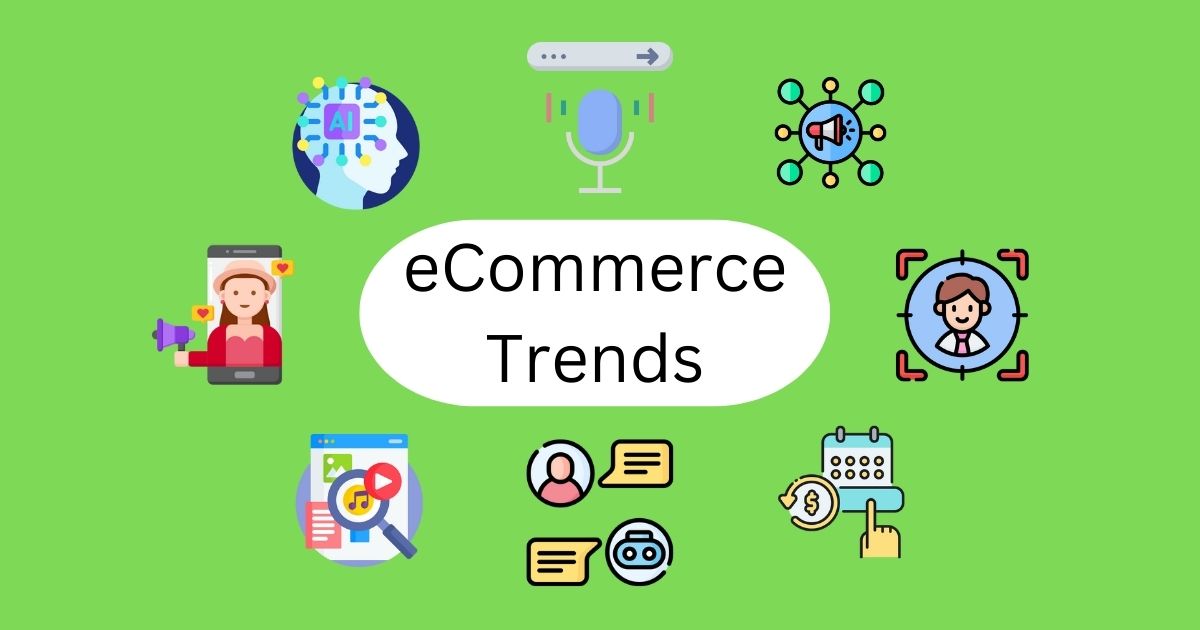Over the past couple of years, the eCommerce market is rising constantly.
In 2017, the eCommerce revenue was about $424.9 billion in the US alone. It increased to $875.2 billion in 2022. The number is estimated to be $1,329.7 billion by 2027.
In the past few years, eCommerce has changed a lot. To get the best out of this rising industry, it’s crucial to pay attention to changing preferences, likes, dislikes, etc. of the customers.
10 eCommerce Trends
To thrive in this ever-changing and competitive industry, Here are the top 10 eCommerce trends you should:
- Voice search
- Chatbots
- Influencer marketing
- Personalized marketing
- Omnichannel selling
- AI and automation
- More payment options
- Content marketing
- Digital catalogs
- Subscription
Voice search
Do you know 40.2% of the United States population use voice search features?
With the increase in the use of voice assistants, more people started to use voice search for different purposes like food ordering, online shopping, etc. Therefore, it’s crucial to pay attention to voice search optimization.
Voice search is different from traditional search queries because what we type isn’t always what we speak.
If your eCommerce store isn’t optimized for voice search, it won’t appear when users make voice search queries.
Chatbots
With a chatbot, you can provide support and an amazing shopping experience to your customers. Integrating a chatbot on your website would help visitors find what they are looking for and solve their queries. It will work as a 24×7 support staff.
Instead of a chatbot, when you hire a human staff 24×7, it can become really expensive. So, with chatbots, businesses can improve customer experience as well as minimize costs.
Influencer marketing
If your eCommerce business is quite new, influencer marketing can be a good way to start gaining traction. You will find influencers in your niche on various digital channels like Instagram, Facebook, YouTube, etc. Select influencers with your target audience so that you can get the best results from the influencer marketing campaign.
For example, if you sell beauty products in your store, select influencers who share makeup or beauty tips & tutorials on their account.
Personalization
Personalization is about using data to provide personalized experiences to the users. It is a great way to improve conversion rates as well as user experience.
If your marketing strategy is generic and you don’t properly understand your audience before running a marketing campaign, you won’t get the expected results. Personalized marketing includes sending out targeted emails, sending custom video messages, providing product recommendations, and more.
Omnichannel selling
Omnichannel selling means providing a great experience to customers across all devices. It is often seen that websites look great on desktop devices, but aren’t optimized properly for mobile devices. In that case, people visiting on mobile phones or tablets won’t get a quality shopping experience. As a result, your conversions will suffer.
Therefore, you need to make sure your eCommerce store is accessible on all devices, including smartphones, tablets, and desktops.
AI and automation
In the eCommerce industry, AI (artificial intelligence) and automation can benefit vendors as well as shoppers. AI and automation can benefit vendors in different ways like order processing, marketing, sales, and more. Talking about customers, AI and automation help them with personalization and better user experience.
More payment options
You got a great product, did amazing marketing, and convinced users to buy from you. But, what if your store doesn’t have payment methods preferred by your potential customers? In that case, you will lose your potential customers.
eCommerce stores nowadays offer a number of payment options for transactions. While offering popular payment options is a must, you should also offer alternative payment options.
If you sell globally, note that the popularity of payment options differs from one country to another. By offering more payment options, you make it easy for all your potential customers to make payments without hassle.
Content marketing
Content marketing lets you inform, educate, and build a connection with your audience. Depending on your online marketing strategy, you can create and share articles, blog posts, videos, podcasts, infographics, etc. on different digital channels.
The purpose of content marketing isn’t just to drive more sales. It’s more about inform & educate the audience and build brand awareness. You can create tutorials, product reviews, behind the scene content, etc.
Digital catalogs
A digital catalog is a document that includes information about the product or service. Digital catalogs are easily shareable as well as easy to maintain. Unlike a physical catalog, updating a digital catalog doesn’t take much time. Furthermore, digital catalogs also save costs on printing and shipping. On your eCommerce store, you can integrate a digital catalog containing information about your products/services.
Subscription model
People have become used to online shopping. With the subscription model, your customers can set up auto purchasing as per their requirements. It could be a daily, weekly, or monthly subscription. This way, you can increase retention rates and increase your revenue.
Note that the subscription model doesn’t work on all products. If you sell items like TV, refrigerator, etc., the subscription model won’t help.
Final Thoughts
The eCommerce market is ever-changing and constantly evolving. To stay ahead of the competition and generate more sales, it’s imperative to follow the latest eCommerce trends. In the end, it comes down to user experience.
Almost all the trends (be it voice search optimization or personalization) revolve around providing a better experience to users. Better customer experience ultimately means more sales.
Also Read:
